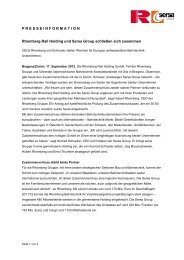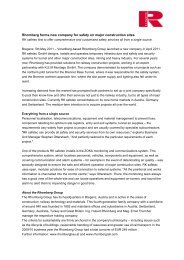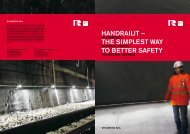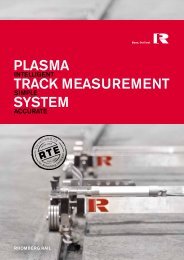Slab track surveying and set-up - Rhomberg Bahntechnik
Slab track surveying and set-up - Rhomberg Bahntechnik
Slab track surveying and set-up - Rhomberg Bahntechnik
You also want an ePaper? Increase the reach of your titles
YUMPU automatically turns print PDFs into web optimized ePapers that Google loves.
SLAB TRACK<br />
RHOMBERG<br />
BAHNTECHNIK<br />
Fig. 6a: Lifting wedge (Hanover - Berlin line)<br />
Fig 6b: Lifting <strong>and</strong> slewing wedge (Wolfsgrubentunnel)<br />
The adjustment procedure should be designed<br />
to be independent of specific slab <strong>track</strong><br />
features such as different systems or cross<br />
sections. It may be used for both monobloc<br />
<strong>and</strong> twin block sleepers as well as for monolithic<br />
or elastically s<strong>up</strong>ported sleepers <strong>and</strong><br />
sleeper blocks.<br />
Highly reproducible quality<br />
The procedures as a whole are designed to<br />
ensure reliable <strong>and</strong> highly reproducible quality<br />
<strong>and</strong> performance throughout all manufacturing<br />
steps on site.<br />
Maximum structure clearance for the<br />
placement of lean concrete<br />
The adjustment system is designed to offer<br />
maximum freedom of movement for subsequent<br />
pouring of lean-mixed filling concrete.<br />
Especially when using concrete mixing machines,<br />
obstructionless operation is an essential<br />
requirement.<br />
Independent s<strong>up</strong>port for the left <strong>and</strong><br />
right rails<br />
The independent s<strong>up</strong>port of the left <strong>and</strong><br />
right rails is of particular importance for special<br />
applications such as switch <strong>and</strong> crossing<br />
work or for expansion joints. Because the<br />
whole system is designed to treat the left <strong>and</strong><br />
right rails separately, it can also be used in<br />
switches without any restriction.<br />
Development steps<br />
In the first step, a simple lifting wedge was<br />
developed <strong>and</strong> used for top correction on<br />
the construction of the new Hanover - Berlin<br />
line (Fig. 6a). In this project, <strong>track</strong>s were aligned<br />
by means of a tamping <strong>and</strong> lining machine.<br />
The wedges were positioned under the<br />
adjusted <strong>track</strong> near the tamping head <strong>and</strong><br />
then tightened. Performances <strong>up</strong> to 950 m<br />
per working shift could be reached by using<br />
this procedure. In the next step, these lifting<br />
wedges were additionally equipped with<br />
horizontal adjustment facilities <strong>and</strong> then used<br />
for <strong>set</strong>ting-<strong>up</strong> six switches <strong>and</strong> 1000 m of<br />
branch line <strong>track</strong> in the Wolfsgruben tunnel<br />
(St. Anton, Austria) (Fig. 6b). Later, this system<br />
was further developed for the new Cologne<br />
- Rhein/Main line.<br />
Loading tests<br />
Extensive preliminary tests were carried out<br />
on a test <strong>track</strong> at the <strong>Rhomberg</strong> company<br />
yard in order to ensure the correct functioning<br />
of the system, especially with regard to<br />
lateral stability.<br />
The <strong>track</strong> was <strong>set</strong> <strong>up</strong> on a carrier plate with<br />
a lateral tilt of 12% (= 180 mm cant). The<br />
<strong>track</strong> was then adjusted <strong>and</strong> exposed to lateral<br />
forces. Track deformations were monitored<br />
to an accuracy of 0.01 mm at the point<br />
of application of the load as well as at both<br />
adjacent s<strong>up</strong>port points on the rail, at the<br />
wedge <strong>and</strong> at the concrete s<strong>up</strong>porting structure,<br />
by means of dial gauges (Fig. 7).<br />
Forces of 1 kN, 2 kN, 3 kN, 4 kN <strong>and</strong> 5 kN<br />
were applied <strong>and</strong> released. In spite of a 2 mm<br />
deformation with 5 kN, the residual deformation<br />
after release was only 0.3 mm.<br />
After this test, the <strong>track</strong> was exposed to an<br />
oscillating load of about 20 kN <strong>and</strong> to vehicle<br />
movement. The residual deformations of 0.3<br />
mm were further reduced through these<br />
vibrations.<br />
This test proved the stability of the adjustment<br />
system to be extremely high <strong>and</strong> the<br />
sensitivity of the adjusted <strong>track</strong> to vibrations,<br />
especially during subsequent pouring of concrete,<br />
to be very low. The concept of the<br />
constraint-free adjustment system treating<br />
the rail as a flexible curve responds benignly<br />
to loads resulting from the construction process.<br />
The experience gained in these tests<br />
was confirmed throughout the Cologne -<br />
Rhein/Main construction site.<br />
RSS <strong>set</strong>-<strong>up</strong> system on the new<br />
Cologne - Rhein/Main line<br />
The RSS survey <strong>and</strong> <strong>set</strong>-<strong>up</strong> system created by<br />
Bahnbau Wels has been used for the construction<br />
of 126 km of slab <strong>track</strong> for the new<br />
Cologne - Rhein/Main line, or 50% of the<br />
whole line.<br />
This <strong>track</strong> alignment system is based on the<br />
following principles (Figs. 8a - 8e):<br />
The rails themselves form the ideal curve<br />
template for an accurate adjustment of the<br />
<strong>track</strong>.<br />
S<strong>up</strong>ports are <strong>set</strong> <strong>up</strong> with lifting <strong>and</strong> slewing<br />
wedges in the space between every third<br />
sleeper, enabling accurate horizontal <strong>and</strong><br />
vertical <strong>track</strong> adjustment <strong>and</strong> fixing directly<br />
on the rail.<br />
The wedges are placed directly on concrete<br />
s<strong>up</strong>ports which are mounted on the<br />
concrete slab base. Set on these nonelastic<br />
s<strong>up</strong>ports, the behaviour of the rails<br />
as curve templates can thus be optimally<br />
exploited.<br />
The lateral forces needed for <strong>track</strong> adjustment<br />
<strong>and</strong> fixing can be discharged by pure<br />
pressure forces directly into the subsoil<br />
without any additional measures. Even with<br />
cant values of 170 mm, this does not present<br />
any problem.<br />
When using long rails, these lifting <strong>and</strong> slewing<br />
wedges are additionally equipped<br />
with longitudinal sliding bearings, thereby<br />
allowing thermal expansion of the rail<br />
without influencing its position <strong>and</strong> height.<br />
The individual components are described as<br />
follows.<br />
Concrete s<strong>up</strong>ports<br />
Pre-fabricated concrete s<strong>up</strong>ports whose qua-<br />
4<br />
Published in EI - Eisenbahningenieur (52) 9/2001 site 15-21<br />
<strong>Rhomberg</strong> Bau AG<br />
A-6900 Bregenz<br />
Tel.: +43 (5574) 403 0<br />
Fax : +43 (5574) 403 249<br />
hubert.rhomberg@rhombergbau.at<br />
www.bahntechnik.com
















